This month’s episode is about what it would take to sterilize the Earth, and why you might want to figure that out in the first place.
First we talk to the authors of a paper that tries to figure out this exact question. David Sloan and Rafael Alves Batista are the authors of a paper called “The Resilience of Life to Astrophysical Events” (along with Avi Loeb). No, they’re not evil scientists, just interested in what it might take to find life on other planets.
They explain their calculations, and how we mostly don’t have anything to worry about. Plus, cool facts about tardigrades!
Then we talk to science-fiction author N.K. Jemisin who is the author of The Broken Earth trilogy. Which is very good! She explains her thinking behind the books, why the Earth is out to get her characters, and how humans banding together to survive is more interesting to her than the lone ranger making it on his own.
Further reading:
- What Would It Take to Completely Sterilize the Earth?
- The Resilience of Life to Astrophysical Events
- Did a gamma-ray burst initiate the late Ordovician mass extinction?
- NASA: Gamma-ray Bursts
- Flash Forward: The Supernova Next Door
- ‘The Fifth Season,’ by N.K. Jemisin
- N. K. Jemisin on Diversity in Science Fiction and Inspiration From Dreams
- The Tardigrade: Practically Invisible, Indestructible ‘Water Bears’
- Tardigrades return from the dead
Flash Forward is produced by me, Rose Eveleth. The intro music is by Asura and the outtro music is by Hussalonia. The episode art is by Matt Lubchansky.
If you want to suggest a future we should take on, send us a note on Twitter, Facebook or by email at info@flashforwardpod.com. We love hearing your ideas! And if you think you’ve spotted one of the little references I’ve hidden in the episode, email us there too. If you’re right, I’ll send you something cool.
And if you want to support the show, there are a few ways you can do that too! We have a Patreon page, where you can donate to the show. But if that’s not in the cards for you, you can head to iTunes and leave us a nice review or just tell your friends about us. Those things really do help.
That’s all for this future, come back next month and we’ll travel to a new one.
▹▹▹▹▹▹▹▹▹▹▹▹▹▹▹▹▹▹▹▹▹▹▹▹▹▹▹▹▹▹▹▹▹▹▹▹▹▹▹▹▹▹▹▹▹▹▹▹▹▹▹▹▹▹▹▹▹▹▹▹▹▹▹▹▹▹
TRANSCRIPT
Rose: Hello and welcome to Flash Forward! I’m Rose and I’m your host. Flash Forward is a show about the future. Every episode we take on a specific possible… or not so possible future scenario. We always start with a little field trip to the future, to check out what’s going on, and then we teleport back to today to talk to experts about how that world we just heard might really go down. Got it? Great!
This year we’re starting in the year TK.
[garbled sounds] [ticking]
Initiate planet list.
Passing Sector QQ7 Active J Gamma
Passing Yavin 4
Passing O G L E -2005 -B L G -390 Lb
K2 3d — K 2 dash 3 — Leo — tidally locked, half scorched half ice — do not send probes, zero success rate — no life
HD 40307 g — K 2.5V — small, warm Neptune without a solid surface — no life
LHS 1140 b — LHS 1140 — Cetus — rocky — single celled life — do not send living probes, neural infections, quarantine all returning probes indefinitely
Sol III — 399 — Sector ZZ9 Plural Z Alpha — mostly water — special note — “also known as Earth, the only known planet to once harbor life but then lose all life forms, only known case of planet sterilization, still unclear means of sterilization — once hosted multicellular life — please see special information packet for more — planet of interest.”
>>> Earth. One of the universe’s great mysteries. We know that life once flourished on this watery planet. We know there were once vast civilizations of both hymenoptera, and bipedal mammals. But today, the planet is sterile. And nobody knows why. Scientists have spent hundreds of years excavating the remains of the biological life on the planet, but can still make no sense of how the living beings interacted with one another. Or how they all simply, vanished. Here we’ll explore several theories as to why life on Earth disappeared… Touch below to begin. Or press [exit] to return to the main menu.
[beep]
Wolf 1061 c — rocky — tidally locked, half scorched half ice — no life — former mineral mining base — watch for drag nets
Kepler-1229b — rocky — tidally locked — multicellular life in terminator line, single cellular life on dark side — often experiencing cultural turmoil — land at your own risk
//end scene
So this episode was inspired by a paper written by two guys, David Sloan and Rafael Alves Batista.
David Sloan: So I’m Dave, or, David Sloan, I’m a postdoctoral research associate at the University of Oxford and I work primarily on theoretical cosmology,.
Rafael Alves Batista: I’m Rafael Alves Batista. I’m a postdoctoral researcher here at the University of Oxford and my main work is in astrophysics and particle physics.
David: So Rafa and I are both working together on a project that we put together a rocket called the consolidation of fine tuning.
Rose: The Consolidation of Fine Tuning is an excellent band name, in my opinion. But in this case it’s a project that’s basically trying to look at situations where there are really, really specific requirements that have to be just right in order to get your desired outcome.
One example of an event that requires very, very fine tuning in order to get an outcome is… life. The development of life on a planet only happens if a TON of factors line up EXACTLY right.
David: we’re really talking about fine tuning of the galaxy and things about the habitable zones within the galaxy for the formation of sort of life and habitable planets.
The problem is that figuring out what has to happen to get life on a planet… is really hard. We only have one example to look at, which is our own planet. And while there are plenty of theories for how life arose on Earth, nobody actually knows for sure how it happened.
David: In fact we don’t know a lot about what it takes for life to exist. We don’t have really. Good boundaries on what. It would take for life to exist partly because we just don’t know what life is outside the context of Earth.
Rose: Figuring out the odds of finding life on other planets has two parts. First you have to figure out how often, and what it takes, to create life. That’s pretty hard. But you also have to figure out how likely it is that life sticks around once it shows up. In other word what is the likelihood that there planets out there that might have had life before, but don’t anymore?
David: Even though a planet might be capable of supporting life, that doesn’t necessarily mean that when you look there you’ll see living things.
Rose: So they decided to tackle this problem from a different direction.
David: And so what we wanted to do was say OK maybe we don’t know how life starts but can we work out how it will get stopped.
Rose: And that is the question that led these researchers to writing a paper called: “The Resilience of Life to Astrophysical Events.” In other words, what it would take to completely sterilize the Earth.
David: So you were looking for. What would it take to kill off life on planets that we are going to start looking at three telescopes over the next couple of decades because they look a bit like Earth.
Rose: So how do you figure out how to kill everything? You could do it the hard way, by trying to model the environment and all the interconnected things that would have to fail to slowly choke out our vibrant planet. Or, you could just pick an organism that’s really hard to kill, and focus on that. Which is what they did.
Rafa: So we have chosen the greats because the Tardigrades are in principle the most resilient form of life that we know
Rose: Tardigrades. I can’t believe I have done 55 episodes of this podcast and this is the first time we’re talking about tardigrades! So tardigrades, as Rafa said, are these incredible little microscopic animals. They are also sometimes called water bears, space bears, or … my favorite… moss piglets. They’re these tiny little creatures that are incredibly difficult to kill.
Rafa: so they can withstand very high temperature. So temperature is very low as well. High levels of radiation are thousands and the levels of radiation that would kill us humans.
Rose: They can live in hot springs, in solid ice, at the bottom of the ocean. They can live without water for 10 years. They’re also the first known animal to survive in outer space. Like outside the space ship. Scientists once put tardigrades into space for 10 days and they lived.
The ironic thing about all of this is that tardigrades are INCREDIBLY difficult to kill … except if you squish them.
David: I mean take for example the Tardigrades right you can squish them between your fingers if you particularistic to sadistic.
So… they’re not magic or anything. But they are also incredibly common so there are a LOT of them.
David: it’s not hard to kill an individual but to kill all of them you have to do something pretty extreme to
Rose: Plus, they live in all sorts of places. Including the deep ocean, which means that a catastrophic event on land, like an asteroid impact or even a huge dose of radiation might not impact them, because they’d be protected by all that water.
All this led the team to the following conclusion: to kill all the tardigrades on the entire planet you have to boil the oceans. That would expose even the hardiest little moss piglets tucked away in the deepest corners of the ocean floor to the heat and radiation that could kill them. And to boil the oceans… that’s… pretty hard to do.
David: so boiling the oceans requires a lot of energy. I mean we are talking like ten to the 26 jewels. To give you know some sort of context. All the nuclear weapons in the world wouldn’t make them. Thomas you know there’s so I mean people love and wonder are really going to kill ourselves at some horrendous nuclear war. Well possibly for humans but things living at the bottom of the ocean probably wouldn’t even notice it but it might go dark for a while. It’s already dark. And so it’s an incredible incredible amount of energy and it really is phenomenally big.
Rose: To deliver that much energy, there are really only a couple of options.
Rafa: So yeah just looking at what we started earlier we have considered the case in which the oceans are prohibited by asteroids. Supernovae are gamma ray bursts.
Rose: So let’s go one by one. Let’s start with the asteroid:
Rafa: And we have actually calculated what Which mass of asteroid would be needed in order to boil all the ocean so And it turns out that these number it’s very big
Rose: Like, 1.7 quadrillion metric tons, big. I tried to find some good comparisons for 1.7 quadrillion metric tons to help put that number in context and it was really hard. It’s really big. The average American, working full-time, would have to work 250 million years to earn 1 quadrillion pennies. Does that help? Probably not… but maybe this will.
Rafa: There are only 17 or maybe 19 objects in the solar system that we know that have enough mass to boil all the water in the ocean
Rose: So that’s number one, the asteroid. And there isn’t one near us, so we’re good. Let’s go to number two, supernova.
Rafa: So supernovae are large explosions. So it’s essentially the end of the life star. So when a massive star dies it explodes in a process that we call the super over a supernova emits a large amount of radiation.
Rose: We did an episode on what would happen if a supernova went off nearby back in season one. It’s not good! But thankfully, there is no star anywhere near us that is close to exploding any time soon. So we’re safe for now.
Rafa: And it turns out that the supernova would need to be about 0.14 light years away in order to boil all the water on the oceans and 0.14 like two years. That’s a ridiculous number because that’s very small. This is eat like humans. The closest star to Earth after the sun Proxima Centauri that’s about 3.7 light years away.
Rose: Sleep well tiny moss piglets, a supernova isn’t coming for you soon. But what about a gamma ray burst?
Rafa: The third one from its gamma ray bursts so gummy bears are not really well understood but they are very energetic Gride explosions and then when you first they somehow seem to supernovae. However the difference is that most of the energy released in the form of a beam
Rose: Here’s a thing I did not know before working on this episode. Gamma ray bursts are these mysterious high energy laser beams that shoot out from space and nobody really knows how they work or what they even are? But we do know that they’re incredibly powerful. In just a couple of minutes, a single gamma ray burst can give off as much energy as our sun will during its entire 10 billion year life! And let me repeat, we do not know what these things are or why they happen. Which … is not terrifying at all!
Rafa: And it turns out that a gamma ray burst about 40 light years away. Would be enough to kill life all forms of life on Earth. Because these are very energetic explosions
Rose: Some scientists actually think that Earth has been hit by at least one gamma ray burst in the past. There are researchers who think that about 450 million years ago a gamma ray burst fried Earth, which led to the second largest extinction event in Earth’s entire history.
But even though that extinction event whiped out almost 85% of marine species, it didn’t sterilize the Earth. Because it turns out that life… is pretty hard to get rid of.
Rose: You said in the abstract “surprisingly,” why is it surprising to you?
David: I wrote the abstract so I spurned the answer. It’s personal right. It’s because I’ve always thought of life as being this very fragile thing you know.
Did it come from the fact that I’m a naive and some more arrogant physicist who’s getting into territory of biology here. You know, wandering into this zone and I’m sure biologists would have said “well we knew this all we knew it’s about life it’s hard to kill these things why are you so surprised about this.”
Well to me it’s genuinely shocking. You know I mean when I think of the number of things that could kill me it petrifies me, just walking down the street. But when you think about sort of generalizing you think about every sort of animal or every creature you’ve ever sort of known. So again it seems like it’s relatively easy to kill individuals. Well then when you try and work out how to kill all of them, or, what it would take to kill them, I’m not Darth Vader or something. So when you work out what it would take to kill all of the species you find that even though individuals are easy, entire populations are somewhat resilient. And that to me was surprising. I really thought that we were going to get the opposite conclusion when we started looking at this. And we were going to say OK maybe it’s very very special that we’ve actually survived.
Rose: Rafa and David specifically avoided talking about humans in their paper. But this is a podcast for humans, so when we come back we’re going to talk about what it might take for humans to survive a cataclysmic event like a gamma ray burst or a giant asteroid.
[[AD BREAK]]
Rose: So in their paper, Rafa and David don’t really talk about humans. And I assumed it was because they thought humans were pretty easy to kill. But that’s actually not it.
David: For human beings this is actually very very difficult because unlike other animals what we really have going in our favor is that we have access to technology. And so when we talk about sort of the ability of a human being to survive and astrophysical event you have to think, “well do they get any warning that it’s coming. What kind of technology do they have access to?”
So for example one of the things we thought about our Tardigrades is can you impact them with a lot of radiation. Well you can impact them with a lot of radiation at the bottom of the ocean you’ve got a lot of shielding of ocean above you. But of course you then think for human beings. Well what if I built a submarine or if I built some kind of environment that I could put below the surface of the earth and I could access that kind of shielding too for a short time, surely I would then survive also. So actually humans I have to say it’s it’s a much harder question and sort of the raw analysis of sort of the biology because humans have access to technology.
Rose: While I was reading their paper, and pondering all the ways in which the Earth could become uninhabitable, I couldn’t help but think about a series of books called the Broken Earth trilogy, written by N.K. Jemisin, otherwise known as Nora. The books center around a world where every so often the Earth rears up and basically tries to kill everything.
Nora: I really just kind of was doing a who’s who of extinction level events that we’ve seen in our own world on repeated occasions and some of them I just kind of was like having fun with you know bears. There’s I mean having fun in a completely sadistic you know horrible evil science fiction fantasy writer way. But you know plague of locusts. No that’s not good enough. A plague of spiders you know whatever. Or you know it was more like plague of fungus or you know that kind of thing. What can I do that is just sort of weirdly destructive. But you know also kind of getting across just how how harmful simple things that are messing with the ecosystem or simple things that sort of teeter the balance of our daily lives kind of out of true.
Rose: Also there is magic.
Nora: I had a dream of a woman who was you know walking towards me with the bad ass power walk thing going on but you know instead of like stuff exploding behind her there was a mountain floating along behind her. And you know this being a dream it kind of somehow knew that she was going to throw it at me and I knew that she was mad at me. And I woke up kind of wanting to know why she was angry and also how could she make mountains float. So I then basically from there I came up with the premise to sort of suit that dream of people who had the ability to not necessarily make mountains float. They don’t just like pick mountains up but they can you know cause tectonic activity. That raises a mountain or shatters it or whatever so you know I established some pseudo science rules for it. I tried to work in a lot of actual science which kind of tends to make the pseudo science magic B.S. go down easier.
Rose: The Broken Earth Trilogy is really, really good. And you don’t have to just take my word for it, the first book, The Fifth Season, won a Hugo Award for best novel in 2016. And then a year later, the second book, the Obelisk Gate, also won the Hugo Award for best novel. The third book of the series just came out, and I’m in the middle of it right now… so nobody send me spoilers.
Anyway, a lot of what the books center around are the ways in which humans survive big horrible extinction level events.
Nora: I mean individual humans are easy to exterminate. We are squishy. Nearly 7 billion humans are a little harder to get rid of. We’re basically an infestation on the planet right now, not necessarily in a terrible negative way but you know if the planet is trying to get rid of us it’s going to have to work really hard at it.
We are not you know simply animals relying on our fur or our skin or whatever to help us survive. And we’ve got our ingenuity we’ve got our learned adaptations from from several millennia of trying to survive on this planet that is constantly trying to kill us just because that’s what evolution is. And we’ve learned to you know kind of retool ourselves fairly quickly. We need to.
So yeah I mean any major extinction level event is probably going to wipe out you know large numbers of us. It will be horrific. People will die people suffer. That is not a good thing. But there will always be you know that one person who happens to be in a tin can under the ocean when whatever you know the thing happens and when those people get back up on the surface if there’s enough of them and they’re able to kind of band together.
Rose: It’s this banding together part that is actually a huge focus of the trilogy — the ways in which people do or don’t work together to try and survive.
Nora: We have always survived better as as cooperative groups we are. We are social animals and you know rugged individualism sounds great you know for for oh kind of romantic fiction purposes but in reality it doesn’t tend to work all that well.
So when you look at actual history and you look at who actually survives disasters it’s the people that work together and the other thing that was kind of going on was my my sort of tendency to read the rugged individualism of fiction and react against that and be like now that’s not realistic. Yeah. I mean it’s romantic it’s fun it’s cool we all love the idea of you know Mad Max as the loner staring romantically and brooding as he watches you know the world burn whatever. You know there’s a part of us that kind of likes that but you know I liked you know Mad Max the latest one Fury Road where you saw a bunch of women working together to to survive. And they were doing better than Max was. And you know at the end of it Max goes off to do his romantic brooding shit again. That’s just the nature of of that’s the nature of how actual human societies work. You know and it irritates me when I see fictional depictions of human societies that do not acknowledge the way societies actually function.
Rose: If a gamma ray boils the oceans, or a supenova comes out of nowhere, well, humans are kind of out of luck.
Nora: Well if it’s a supernova you know that’s you know we’re we’re not going to make that.
Rose: But if it’s something less that that, something that kills almost everything, then humans might make it. And unlike David, Nora wasn’t really surprised to hear that it would be really really hard to exterminate life on Earth.
Nora: No. I mean among other things you know I part of the problem is that I’ve got people sending me like weird science stuff all the time because they know I’m interested in it. You know I’ve seen the the article about the sharks living inside an underwater volcano and you know I’ve researched Tardigrades there. Tardigrades are bad as hell. The world will be inherited by Tardigrades if we nuke ourselves you know or something else.
You know when you when you realize that there is life literally in every niche of the planet and probably in the ashes that we haven’t even explored yet you know there’s life in volcanoes there’s life in acid seas there is life in you know places that we think are completely inimical and therein apical to us. But you know there’s no oxygen there. Fine no problem. It used to not have a whole lot of oxygen on it. Surprise things live back then too. So I mean life is tenacious as hell. I love the tenacity of life. The question becomes whether our life is tenacious enough to make it.
Rose: And… we might be? Or we might not be. WHO KNOWS MAYBE A GAMMA RAY WILL JUST COME OUT OF NOWHERE AND FRY US. Why hasn’t anybody told me about this before…. It seems like important information to know.
Okay that’s all for this future, I have to go stress out about gamma rays… come back in a month for a new one!
Flash Forward is produced by me, Rose Eveleth. The intro music is by Asura and the outtro music is by Hussalonia. The episode art is by Matt Lubchansky.
If you want to suggest a future we should take on, send us a note on Twitter, Facebook or by email at info@flashforwardpod.com. We love hearing your ideas! And if you think you’ve spotted one of the little references I’ve hidden in the episode, email us there too. If you’re right, I’ll send you something cool.
And if you want to support the show, there are a few ways you can do that too! We have a Patreon page, where you can donate to the show. But if that’s not in the cards for you, you can head to iTunes and leave us a nice review or just tell your friends about us. Those things really do help.
That’s all for this future, come back next month and we’ll travel to a new one.

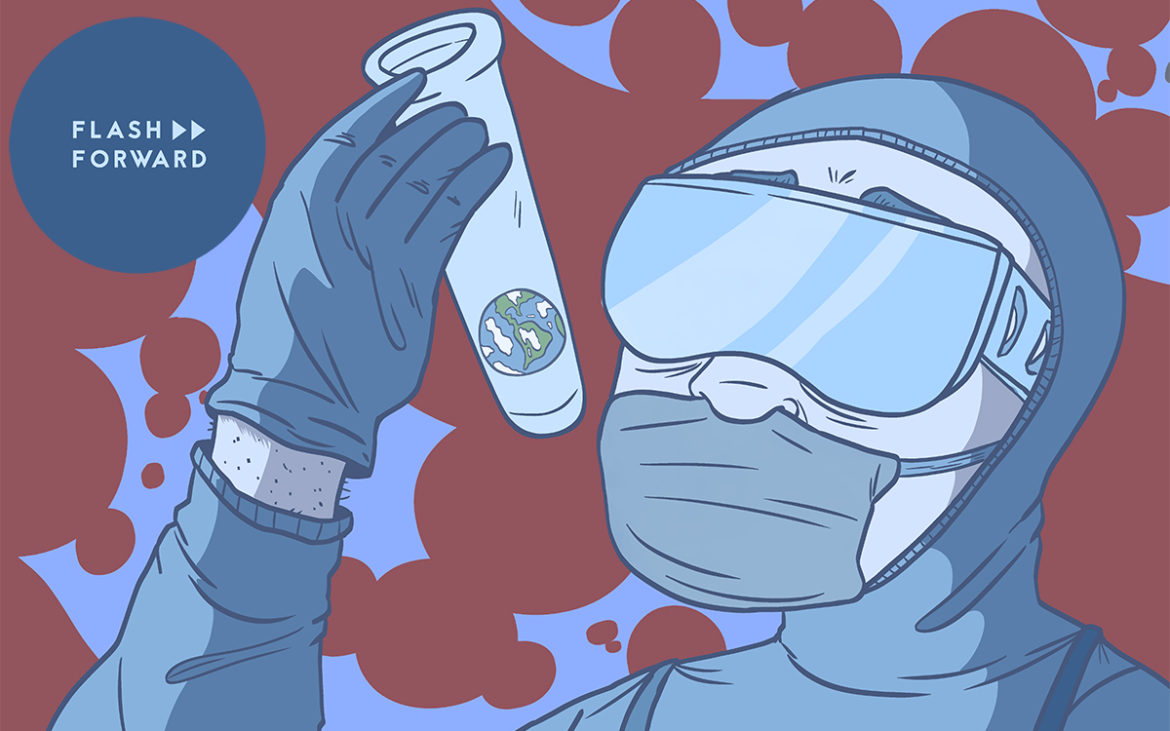
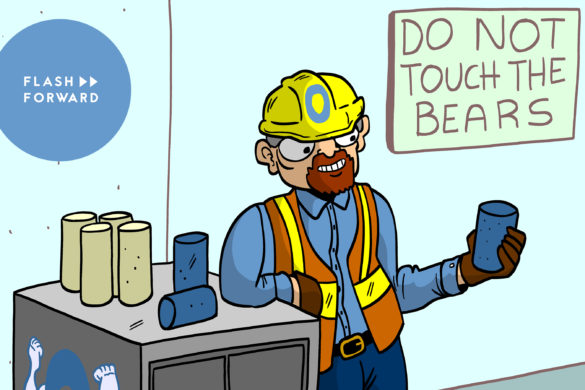


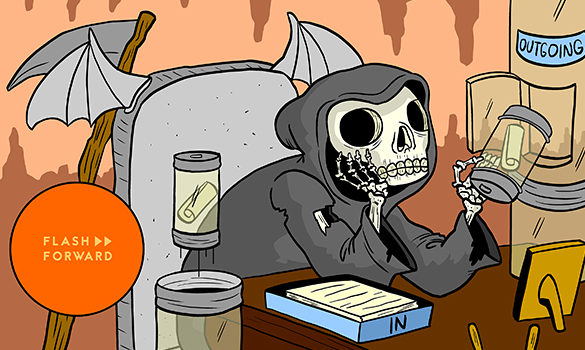
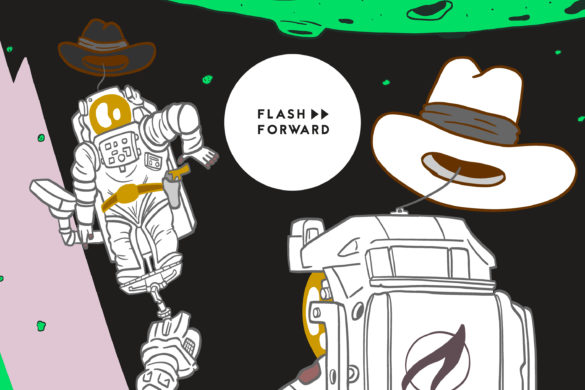
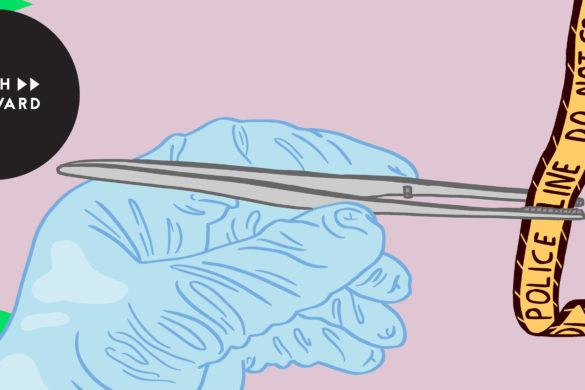

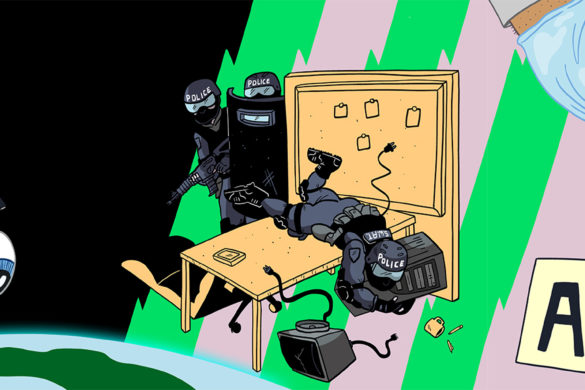
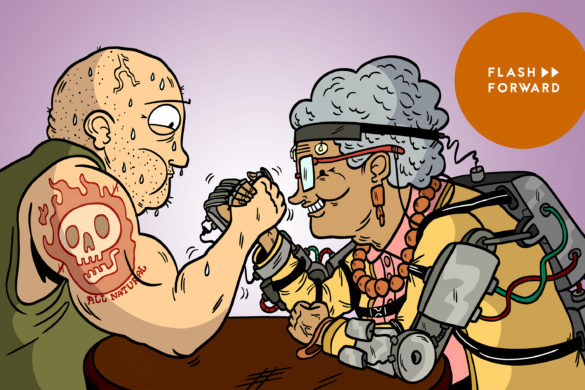
3 comments
So, are gamma ray bursts deadly in their own right or because they turn us all into The Hulk and we kill each other until there aren’t enough to maintain the Hulk species?
Gamma Ray Bursts are utterly terrifying. Kurzgesagt did a pretty neat video about them: https://www.youtube.com/watch?v=RLykC1VN7NY
This was a surprisingly hopeful episode. Between how tough life is and how humans actually work together, (even if it doesn’t seem like it most of the time), those ideas make me happy.